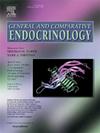雌性激素受体基因在多毛纲动物中生命周期的表达
IF 1.7
3区 医学
Q3 ENDOCRINOLOGY & METABOLISM
引用次数: 0
摘要
脊椎动物雌激素受体(er; NR3A亚家族基因)对调节脊椎动物的多种生物过程至关重要。然而,对无脊椎动物的er (NR3D亚家族基因)知之甚少。小头藻(Capitella teleta)是一种具有单一内质网基因的海洋多毛藻,在体外用低浓度雌二醇激活配体;然而,这种受体的生理作用尚不清楚。我们采用全安装原位杂交技术研究了ER在幼虫期的时空表达模式,并采用RT-qPCR技术检测了不同年龄和性别的ER基因在幼年和成年期的时空表达模式。ER基因在多个幼虫阶段的大脑和前肠中表达,表明其在大脑和胃肠道发育中起作用。幼鼠全身ER基因表达在2周龄和6周龄之间相似。在性成熟蠕虫的头部碎片、胃肠道系统或整个身体之间,ER的表达在性别上是相似的。这些数据表明,内质网并没有表现出脊椎动物中典型的两性二态表达,这表明内质网在C. teleta的性成熟中可能没有发挥重要作用。总的来说,ER在生命的多个阶段表达,表明其在大脑和前肠发育中起作用,并可能在成人的胃肠道功能中起作用。本研究有助于揭示光线虫内质网的生理功能。本文章由计算机程序翻译,如有差异,请以英文原文为准。
Expression of the estrogen receptor gene across the life cycle in the polychaete, Capitella teleta
Vertebrate estrogen receptors (ERs; NR3A subfamily genes) are essential for regulating multiple biological processes in vertebrates. However, little is known about ERs (NR3D subfamily genes) in invertebrates. Capitella teleta is a marine polychaete with a single ER gene that is ligand-activated with low concentrations of estradiol in vitro; yet the physiological role of this receptor is unclear. We used whole-mount in situ hybridization to investigate spatial and temporal expression patterns of the ER in larval stages and RT-qPCR to detect temporal ER gene expression patterns across age and sex in juvenile and adults. The ER gene was expressed in the brain and foregut across multiple larval stages, suggesting a role in brain and gastrointestinal development. Whole-body juvenile ER gene expression was similar between two and six weeks of age. ER expression was similar across sex between head fragments, gastrointestinal systems, or whole bodies of sexually mature worms. These data show that the ER does not exhibit a sexually dimorphic expression as is stereotypical in vertebrates, and suggests that the ER may may not play a big role in sexual maturation in C. teleta. Collectively, ER is expressed across multiple life stages and suggests a role in brain and foregut development, and possibly a gastrointestinal function in adults. This study aids in uncovering the physiological functions of ER in lophotrochozoans.
求助全文
通过发布文献求助,成功后即可免费获取论文全文。
去求助
来源期刊

General and comparative endocrinology
医学-内分泌学与代谢
CiteScore
5.60
自引率
7.40%
发文量
120
审稿时长
2 months
期刊介绍:
General and Comparative Endocrinology publishes articles concerned with the many complexities of vertebrate and invertebrate endocrine systems at the sub-molecular, molecular, cellular and organismal levels of analysis.
 求助内容:
求助内容: 应助结果提醒方式:
应助结果提醒方式:


